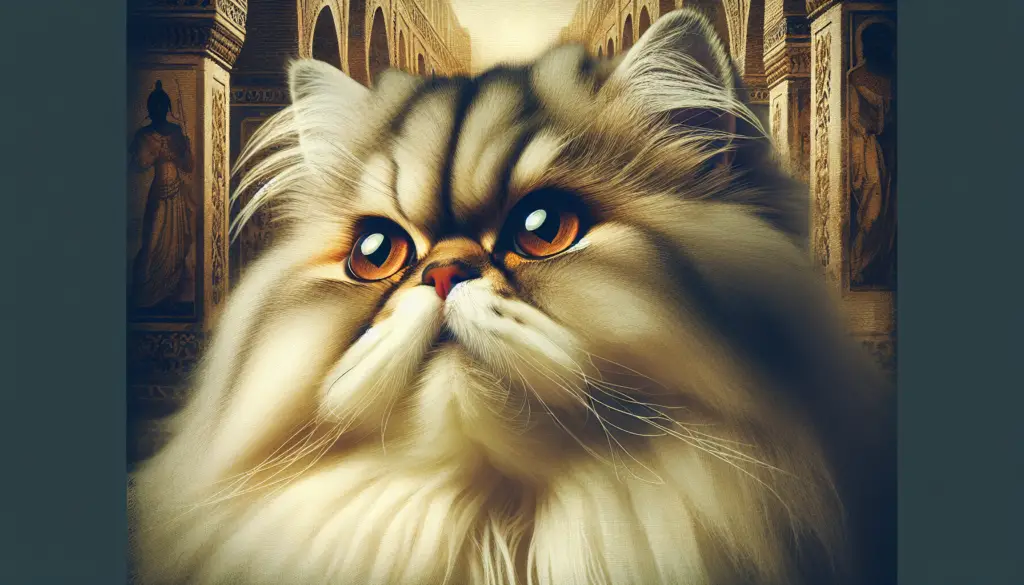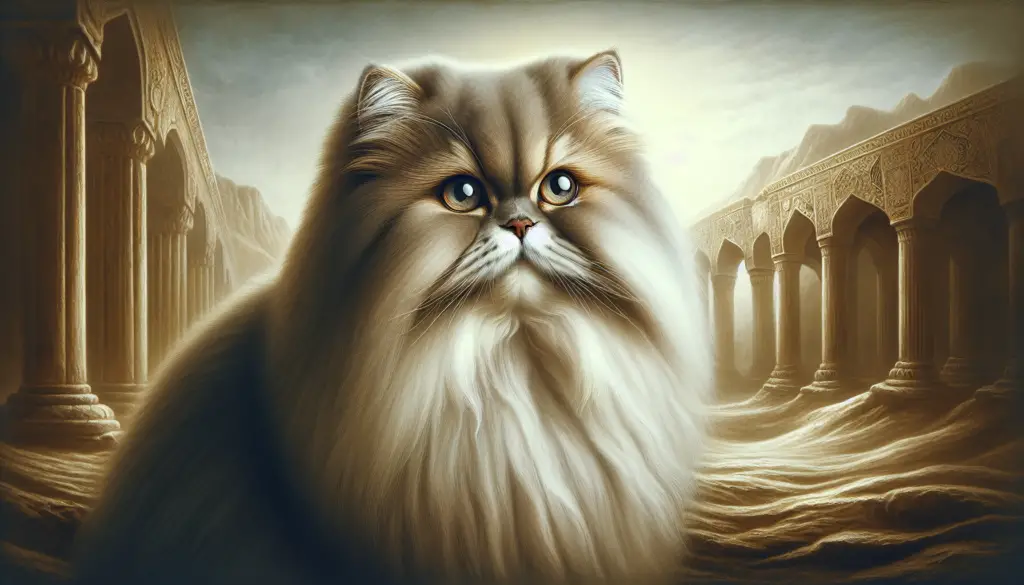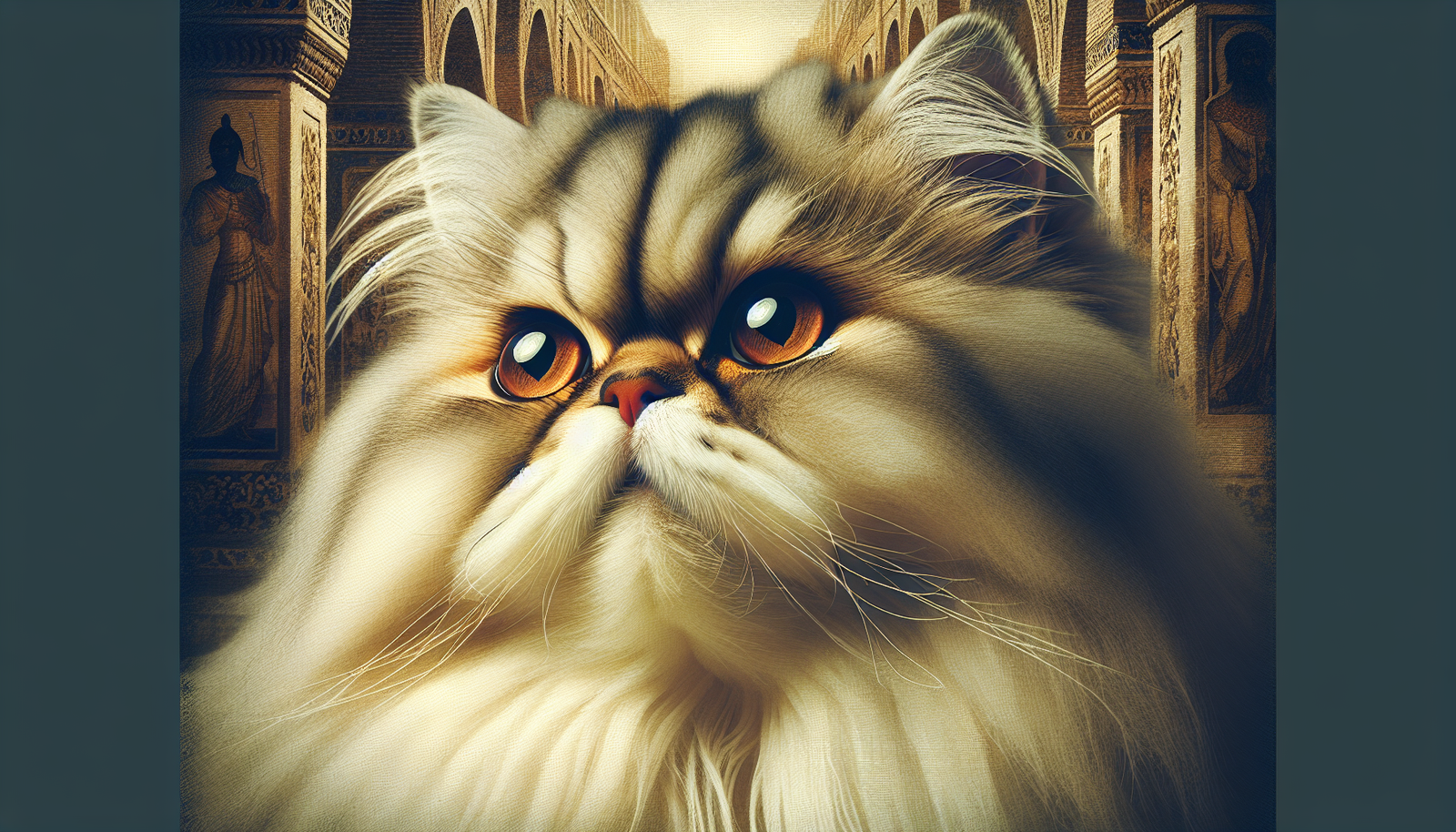Persian cats, with their striking long coats and expressive eyes, have captured the hearts of cat lovers around the world. But have you ever wondered where these majestic felines originated from? Well, let me take you on a fascinating journey through history to uncover the origins of Persian cats. From their humble beginnings in the ancient land of Persia to their emergence as one of the most beloved cat breeds today, this article sheds light on the captivating story of the Persian cat. So, get ready to embark on an adventure of discovery as we unravel the secrets behind these enchanting creatures.
Ancient Origins
Historical Documentation
Persian cats have a rich and intriguing history that dates back centuries. While exact origins are somewhat uncertain, historical documentation suggests that these elegant felines were first recognized and bred in Persia (modern-day Iran) around the 17th century. Persian cats were highly regarded by Persian nobility, and their presence was well-documented in ancient manuscripts and writings from that era.
Feline Ancestors
The ancestors of Persian cats are believed to be long-haired cats from the mountainous regions of Persia. These feline predecessors had a natural adaptation to the harsh climate, with their luxurious coats providing insulation in the cold winters and protection from the scorching sun in the summer. Over time, these native long-haired cats were selectively bred to enhance their unique characteristics and create the exquisite Persian breed we know today.
Persian Cat Characteristics
Characterized by their luscious, long silky fur, expressive eyes, and gentle demeanor, Persian cats have become synonymous with elegance and beauty. They have a distinct round face with a flat nose and small, rounded ears. Persian cats also come in a wide variety of colors and patterns, ranging from solid colors like white, black, and blue, to more intricate patterns such as tabby, calico, and tortoiseshell. Their calm and friendly nature has made them beloved pets and show cats worldwide.
The Land of Persia
Persian Influence on the Breed
The historical significance of the Persian region cannot be overstated when it comes to the development of the Persian cat breed. The geographical landscape and climate of Persia greatly influenced the characteristics of these felines. The Persian cats’ ancestors, being native to Persia, adapted to the diverse terrains and extreme weather conditions, which shaped their physical attributes and helped them survive in their natural environment.
Cultural Significance
Within Persian culture, cats were held in high regard. They were considered sacred creatures and treated with utmost respect and admiration. Persian poets and scholars often immortalized cats, particularly Persian cats, in their works of art and literature. Their regal appearance and serene nature made them a symbol of grace, beauty, and wisdom in Persian society.
Royal Favoritism
Persian cats had a special place in the hearts of Persian royalty. These majestic cats enjoyed pampered lives within the palaces and were treasured companions to Persian kings and queens. Persian rulers had a penchant for breeding these exquisite felines, creating a legacy that further solidified the Persian cat’s significance and prestige.

Export and Popularity
Initial Exportation
The popularity of Persian cats began to spread beyond the borders of Persia during the 17th century. As Persia engaged in trade and diplomatic relations with various nations, these beautiful felines caught the attention of foreign dignitaries and aristocrats. The exportation of Persian cats from Persia to other countries marked the beginning of their global journey and increased their recognition and desirability worldwide.
Growing Demand
With the exportation of Persian cats came a growing demand for these exquisite felines. The allure of their luxurious, flowing coats and gentle temperament captivated cat enthusiasts in Europe and beyond. As the demand for Persian cats increased, breeders in various countries started to develop their own lines, contributing to the diversification of the breed and the emergence of regional variations.
Spread Across Continents
Over time, Persian cats achieved global popularity and spread to nearly every continent. From Europe to America, from Asia to Africa, Persian cats found their way into homes and hearts worldwide. Their unmistakable beauty and affectionate nature transcended cultural boundaries and made them sought-after companions in households of all backgrounds.
Precious Companions
Persians as Pets
Persian cats are undoubtedly one of the most cherished and beloved pet breeds. Their gentle, easy-going temperament makes them ideal companions for individuals and families alike. These cats thrive in a calm and peaceful environment, where they can enjoy ample lap time and gentle affection from their human companions. Persian cats are known to be quiet, undemanding, and patient, making them suitable for both experienced cat owners and first-time pet parents.
Breed Standardization
The establishment of breed standards played a crucial role in maintaining the unique characteristics of Persian cats. Cat fanciers and breed associations collaborated to define the desired physical attributes, such as head shape, eye color, and coat texture, that distinguish Persian cats from other breeds. These standards serve as a benchmark for breeders and ensure that the breed’s distinct features are preserved and maintained with every generation.
Breeding Techniques
Breeding Persian cats requires a delicate balance between preserving desirable traits and minimizing potential health issues associated with extreme features. Responsible breeders prioritize the health and well-being of the cats, selecting breeding pairs that exhibit robust health and sound temperament. By employing careful breeding techniques and genetic testing, breeders aim to produce healthy, well-rounded Persian kittens that adhere to breed standards while promoting overall feline welfare.

Influence on Other Breeds
Exotic Shorthair
One of the most notable breeds to be influenced by the Persian cat is the Exotic Shorthair. Exotic Shorthair cats were developed by selectively breeding Persians with shorthaired cats, such as the American Shorthair. This crossbreeding resulted in a breed with the Persian’s distinct facial features, but with a dense, plush coat that requires less grooming. The Exotic Shorthair retains the Persian’s gentle and affectionate nature, making them popular choices for individuals who admire the Persian look but prefer a shorter coat.
Himalayan
The Himalayan, or “Himmy,” is another breed closely related to the Persian cat. Originating from breeding programs in the mid-20th century, Himalayans are the product of crossing Persians with Siamese cats. These cats inherited the Persian’s luxurious coat and distinctive facial features, combined with the Siamese’s striking blue eyes and colorpoint pattern. The Himalayan cat breed quickly gained recognition and popularity due to the combination of these two beloved breeds.
Doll Face Persians
In recent years, a movement advocating for the preservation of the traditional facial structure of Persian cats has gained momentum. These cats, known as “Doll Face Persians,” have a less extreme facial appearance compared to the flat-faced Persians seen in modern cat shows. The Doll Face Persian movement strives to retain the original charm and health of the breed by promoting a more natural facial structure. This alternative perspective on Persian cats has attracted a passionate following of individuals who appreciate the breed’s original form.
Recognition by Cat Fancy Associations
Early Recognition
The distinctive beauty and elegance of Persian cats were recognized by cat fancy associations in the late 19th century. As the popularity of cat shows grew, Persian cats became a mainstay of these competitions due to their luxurious coats and regal presence. The Cat Fanciers’ Association (CFA) in the United States and other similar organizations around the world have provided platforms for showcasing Persian cats and promoting the breed’s unique qualities.
Persian Breed Standards
Cat fancy associations established specific breed standards to uphold the ideal appearance and qualities of Persian cats. These standards describe the desirable physical attributes, including head shape, body type, coat color, and eye color. Judges at cat shows evaluate Persian cats based on these breed standards, ensuring that only cats that meet the specified criteria receive recognition and awards.
Show Competitions
Cat shows are an integral part of the Persian cat community, providing a platform for breeders, owners, and enthusiasts to showcase the beauty and elegance of the breed. These competitions allow Persian cats to compete against their peers, with judges evaluating their adherence to breed standards, grooming, and overall presentation. Winning titles and accolades at cat shows further enhance the prestige and popularity of Persian cats.
Continued Breeding Practices
Selective Breeding
Selective breeding is a key aspect of maintaining and improving the breed’s distinctive traits. Breeders meticulously choose breeding pairs based on their lineage, health, temperament, and adherence to breed standards. By pairing cats with complementary qualities, breeders strive to produce kittens that possess the desired physical characteristics and temperament while minimizing the risk of hereditary health issues.
Maintaining Desired Traits
Breeding Persian cats involves a delicate balancing act of preserving desirable traits while addressing potential health concerns. Breeders carefully select for traits such as the luxurious coat, large expressive eyes, and docile temperament that exemplify the breed standard. Simultaneously, they work towards addressing potential health challenges associated with the Persian breed, such as breathing difficulties and eye problems.
Challenges in Breeding
Breeding Persian cats presents unique challenges due to their characteristic physical features. Their distinctive flat face, shortened muzzle, and long, dense coat require dedicated grooming and attentive care. These features can also predispose Persian cats to certain health issues, including respiratory problems and eye conditions. Responsible breeders are vigilant in managing these challenges, regularly consulting with veterinarians and employing ethical breeding practices to ensure the health and well-being of the breed.
Admiration for Persian Cats in Art and Literature
Persian Cats in Paintings
The undeniable beauty and elegance of Persian cats have captivated artists for centuries. Paintings and portraits featuring Persian cats as their subjects provide a captivating glimpse into the historical fascination with these regal felines. From renowned artists like Jean-Baptiste-Simeon Chardin to modern-day painters, Persian cats continue to grace the canvas, embodying grace, poise, and refinement.
Persian Cats in Books
Persian cats have also made their mark in literature, becoming beloved characters in numerous books and stories. From children’s books to classics of world literature, the captivating charm and unique persona of Persian cats have inspired authors to include them as valued companions and symbols of beauty, elegance, and even mystery. These literary depictions have further solidified the place of Persian cats in the hearts and imaginations of readers across the globe.
Symbolism and Significance
The visual appeal of Persian cats, with their luxuriant coats and serene expressions, has imbued them with symbolic significance in various cultures. Throughout history, Persian cats have been associated with qualities such as wisdom, grace, and tranquility. Their presence in art and literature has reinforced these symbolic meanings, elevating Persian cats to iconic status in the world of feline admiration.
Health Concerns
Genetic Predispositions
While Persian cats are known for their beauty and gentle nature, they do have some genetic predispositions to certain health issues. The breed’s characteristic facial structure can lead to brachycephalic airway syndrome, which may cause breathing difficulties. Persian cats are also prone to eye conditions, including tear duct abnormalities, progressive retinal atrophy, and cherry eye. Responsible breeders and owners are diligent in monitoring their cats for potential health concerns and seeking appropriate veterinary care.
Common Medical Conditions
In addition to the breed-specific health issues, Persian cats may also be susceptible to common feline ailments, such as dental disease, obesity, and urinary tract problems. Regular veterinary check-ups, a balanced diet, and maintaining a healthy weight are essential for ensuring the overall well-being of Persian cats. Good dental hygiene, including regular brushing, can help prevent dental issues that can arise from the breed’s facial structure and dense coat.
Care and Prevention
Taking care of a Persian cat involves regular grooming to maintain their beautiful coat and prevent matting. Their long fur requires daily brushing to keep it tangle-free and prevent hairballs. Additionally, regular eye cleaning is vital for removing discharge and preventing potential eye infections. Ensuring a clean litter box, a balanced diet, and regular exercise can mitigate the risk of obesity and urinary tract problems.
Modern Persians: Building on Tradition
Evolution of the Breed
As Persian cat breeding evolved over time, variations within the breed emerged, resulting in different Persian cat types. These varieties include traditional or doll face Persians, flat faced Persians (commonly seen in cat shows), and even Persian cats with distinct color patterns and coat textures. While still maintaining their signature beauty and gentle temperament, these variations reflect the evolving preferences and continued development of the Persian cat breed.
Different Persian Varieties
The Persian cat breed has diversified into a range of delightful variations, each with its own unique aesthetic charm. Some varieties include the silver Persian, known for its shimmering coat, the chinchilla Persian with its striking white and silver fur, and the smoke Persian with its striking contrast between solid and tipped coat colors. As the breed continues to captivate cat enthusiasts, breeders and cat fanciers are constantly exploring new possibilities, leading to the emergence of additional Persian cat varieties.
Contemporary Popularity
Despite the diverse range of cat breeds available, Persian cats remain perennial favorites among cat lovers worldwide. The breed’s undeniable beauty, calm demeanor, and regal presence continue to enchant and captivate individuals seeking feline companionship. Whether adopting a Persian cat for their striking appearance, gentle nature, or historical significance, these majestic felines continue to hold a special place in the hearts and homes of cat enthusiasts around the globe.
In conclusion, the origins of Persian cats can be traced back to the ancient region of Persia, where they were revered for their beauty and grace. Over the centuries, Persian cats have garnered admirers across the globe, leaving an indelible mark in art, literature, and the hearts of cat enthusiasts. From their royal favoritism in Persia to their widespread exportation and influence on other breeds, Persian cats continue to be cherished companions and symbols of elegance and refinement. While the breed faces unique health challenges, responsible breeding practices and attentive care ensure the ongoing welfare and preservation of this beloved breed. As the Persian cat continues to evolve and diversify, its timeless allure remains as captivating as ever, making it a cherished pet and a source of inspiration for generations to come.

